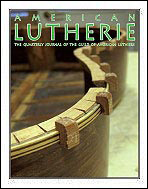 |
|
|||||
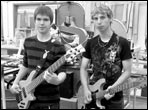 |
Letters to the Editor Tyrell and Joshua are a couple kids lucky enough to go to a high school where the shop teacher helps them build real legit electric guitars. You rock, Mr. Friesen! |
|||||
 |
Meet The Maker: Mike Doolin by Jonathon Peterson Mike Doolin's innovative and distinctive double-cutaway steel string guitars have made a real impression over the last sixteen years or so. Mike does all kinds of interesting stuff, like using a house as a super-duty go-bar deck to form an arched maple-laminate guitar top, or anodizing aluminum parts with a battery charger. Read all about his life and work in this issue. |
|||||
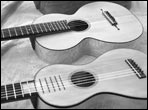 |
19th-Century Guitar Making Techniques from his 2008 Convention workshop by James Buckland James Buckland is a professor of early guitar music. He has built a number of nice copies of 19th-century guitars for his own concert work, and he shows us some super-low-tech methods he developed for doing things like setting bone frets and inlaying rosettes. Electricity? We don't need no stinking electricity! |
|||||
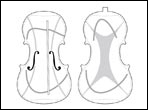 |
Violin Free Plate Mode Tuning Reprised by Edgar B. Singleton A lot of people use dancing glitter to guide them in graduating violin plates. Singleton gives simple, direct advice for getting the mode frequencies where you want them with the least cutting. It has to do with understanding how the node lines overlap. |
|||||
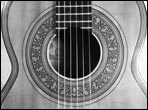 |
Restoring an 1869 Francisco González Guitar by Don Pilarz This gorgeous 140-year-old classic guitar had been seriously messed up as the result of several sessions of repair by insufficently-skilled workers. It's a jungle in there. Pilarz removes the top and makes a full restoration. The article incudes a preview of GAL Instrument Plan #62. (GAL Instrument Plan #47 is also an 1869 Gonzales, but the two guitars have significant differences in plate arching, top bracing, and back bracing.) |
|||||
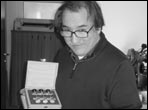 |
Meet the Maker: Nicolò Alessi by Federico Sheppard The above restoration used a beautiful new set of old-style tuners made by Italian machinist Nicolò Alessi at his home and shop near Lago Maggiore. Federico Sheppard introduces us to Alessi, and we get some info on his work, equipment, and philosophy. |
|||||
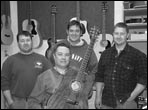 |
Meet the Makers: Waldron Guitars by Roger Alan Skipper When the recession hit the construction industry, this forward-thinking family jumped right over into lutherie production, offering a wide range of steel strings, solidbodies, banjos, and violins. They were already harvesting and kiln-drying their own lumber, and even had a big CNC machine for cabinet work. Now they have added a laser cutter and a whole bunch of more-familiar technology, like go-bar decks and cam clamps. |
|||||
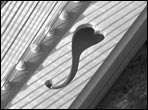 |
Making a Gothic Harp by Shaun Newman Newman's daughter wanted a harp “like the angels play.” He filled that request with a pretty little 26-string Gothic harp. His next assignment: bring home a pink unicorn. And a pot of gold couldn't hurt. Click the photo to see the cool old foot-powered lathe that he used to make the boxwood bridge pins. |
|||||
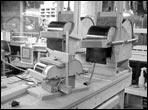 |
Fox Bender Upgrades and Bending Updates by John Calkin Over at Huss & Dalton, they bend more sides than the average luthier, but fewer than, say, Taylor or Martin. They do it by maximizing the effectiveness of the familiar Fox-style bender. The latest tricks include spring-steel sheets, brown paper, aluminum foil, and “the magic juice.” |
|||||
 |
A Method for the Design of the Guitar Body Outline, Part 3 by R.M. Mottola In American Lutherie #97, Mottola showed us how to draw most guitar outlines using only five circles and three straight lines. Notable exceptions were the Martin OM and the Selmer Maccaferri, both of which have “hips” that are not produced by the five-circle method. Here's the updated version using seven circles and three straight lines. Hip, hip, hooray! (Sorry about that.) |
|||||
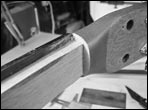 |
A Special Guitar Neck Modification by Ralph Bonte Bonte's customer had lost his left thumb in an accident. The solution was to radically expand the depth of the guitar neck to fit the new ergonomic possibilities. You won't find a guitar like this on Craigslist. |
|||||
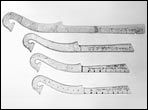 |
Reviews: Pollens' Stradivari by David Gusset Pollens spent many years as the curator of the musical instrument collection at the Metropolitan Museum of Art. He has written a book on the life and work of history's best-known name in lutherie, Antonio Stradivari. Or “Tone Man” as we like to call him. Our review is by violin maker David Gusset. |
|||||
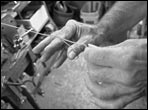 |
 |
It Worked for Me by Steve Card and
Neil Smith Steve Card shows some advanced techniques for getting more life out of used guitar strings, to help us all get a little greener. I'm talking about natural resource responsibility, not the green schmutz that gets in the windings. Neil Smith runs through his process for making a replacement pickguard for an older Gibson flattop. |
||||
| Questions edited by R.M. Mottola What's the deal with the Lacey Act? Is a Martin size 1 a terz guitar? What's the best glue for humid climates? Shall I refinish my old violin? |
||||||
| Lutherie Curmudgeon by John Calkin The differences between various suitable lutherie woods are not as significant as you think. If it's pretty, workable, and stable, go ahead and make a guitar out of it. And if they want some high-priced exotic, charge like crazy for it. It's not unfair; it's business. So says the Lutherie Curmudgeon. |
||||||
Web Extras |
||||||
